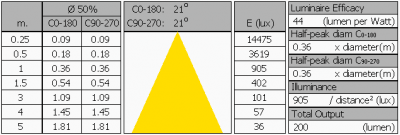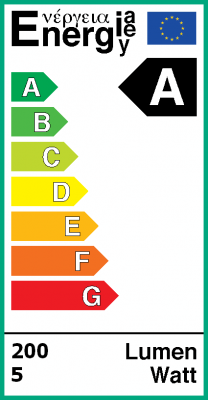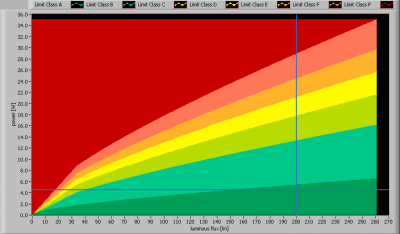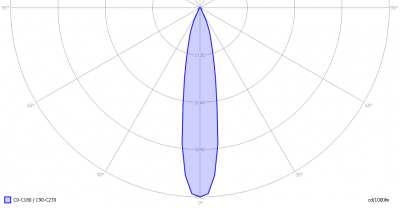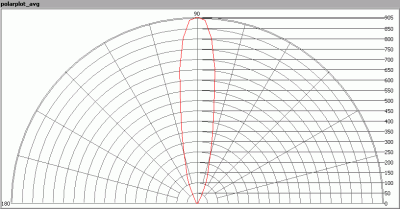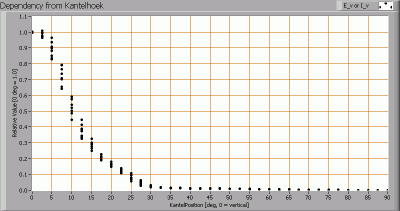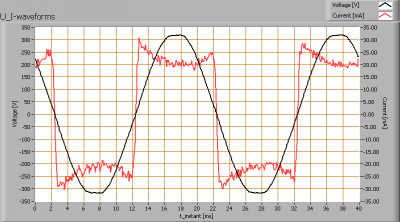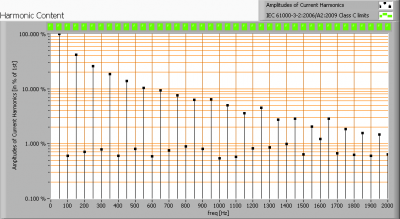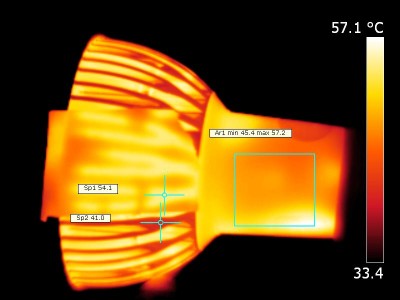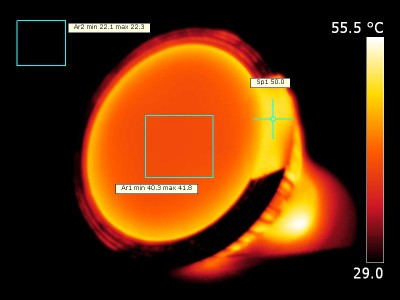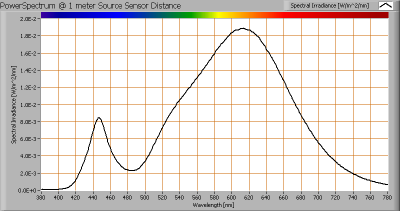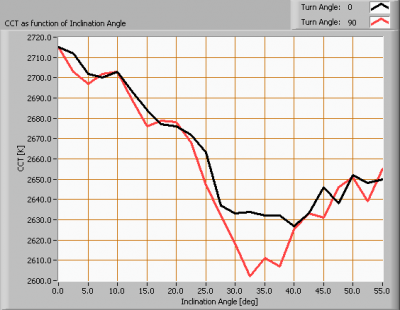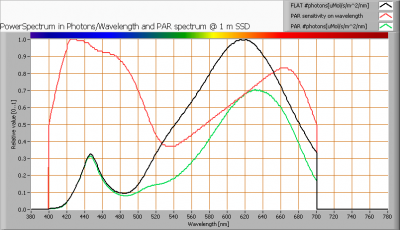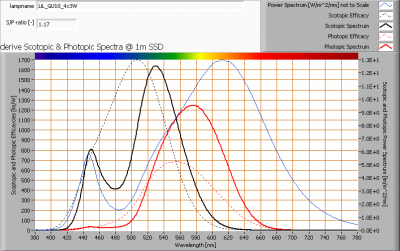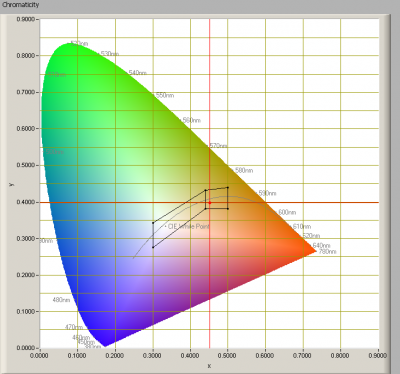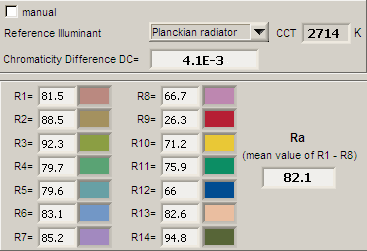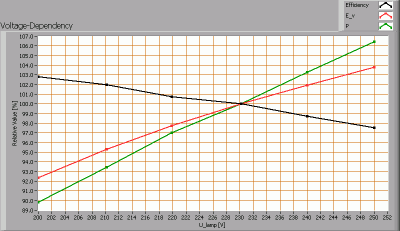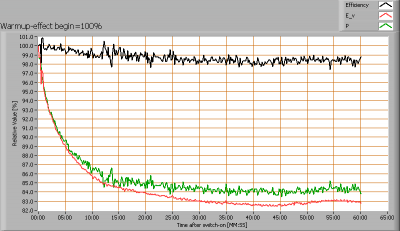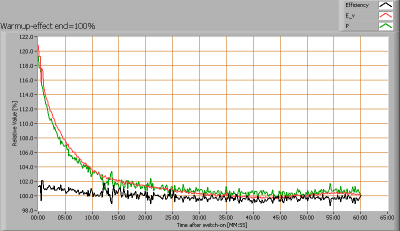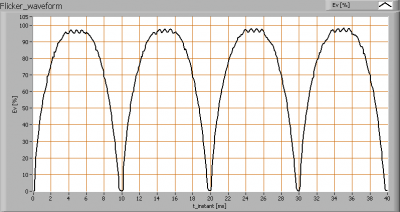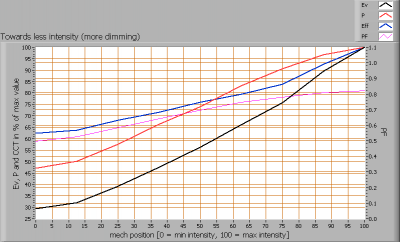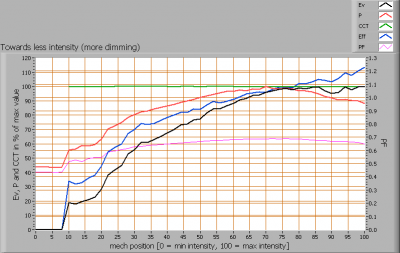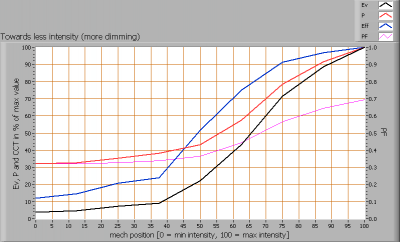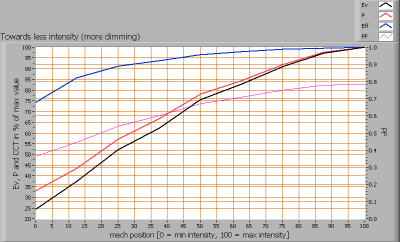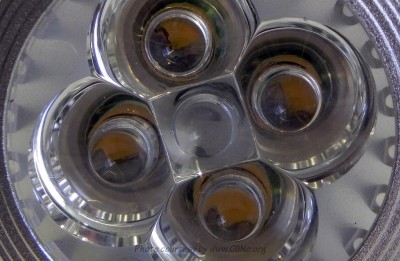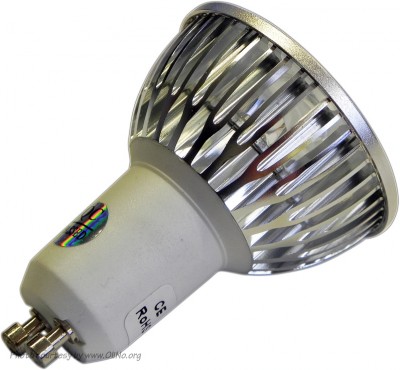LED IT LIGHT – Gu10 4×1.5Watt – CREE 2700K – dimmable
Posted by Marcel van der Steen in Light measurements No Comments» presents herewith a led spotlamp that emits a warm white light.
presents herewith a led spotlamp that emits a warm white light.
Also is tested on dim-ability with the dimmers available by OliNo.
This article shows the measurement results. Many parameters are also found in the Eulumdat file.
See this overview for a comparison with other light bulbs.
Summary measurement data
| parameter | meas. result | remark |
|---|---|---|
| Color temperature | 2714 K | warm white |
| Luminous intensity Iv | 904.7 Cd | Measured straight underneath the lamp. |
| Illuminance modulation index | 101 % | Measured with a light sensor looking at the lamp (angle not defined). Is a measure for the amount of flickering. |
| Beam angle | 21 deg | 21 deg is the beam angle for all C-planes since the lamp is symmetrical along its 1st axis. |
| Power P | 4.5 W | Follow the link for more information on electrical properties. |
| Power Factor | 0.80 | An electrical load with this power factor means that for every 1 kWh net energy consumed, there has been 0.74 kVAhr for reactive energy. |
| THD | 58 % | Total Harmonic Distortion. |
| Luminous flux | 200 lm | |
| Luminous efficacy | 44 lm/W | |
| EU-label classification | A | The energy class, from A (more efficient) to G (least efficient). |
| CRI_Ra | 82 | Color Rendering Index. |
| Coordinates chromaticity diagram | x=0.4520 en y=0.3980 | |
| Fitting | GU10 | This lamp is connected directly to the grid voltage. |
| PAR-value | 9.2 uMol/s/m2 | The number of photons seen by an average plant when it is lit by the light of this light bulb. Value valid at 1 m distance from light bulb. |
| PAR-photon efficacy | 0.5 uMol/s/We | The total emitted number of photons by this light, divided by its consumption in W. It indicates a kind of efficacy in generating photons. |
| S/P ratio | 1.2 | This factor indicates the amount of times more efficient the light of this light bulb is perceived under scotopic circumstances (low environmental light level). |
| D x H external dimensions | 50 mm x 55 mm | External dimensions of the lamp. |
| D luminous area | 37 mm | Dimensions of the luminous area (used in Eulumdat file). It is the surface of the transparant plastic plate in front of the leds. |
| General remarks | The ambient temperature during the whole set of illuminance measurements was 22.6 – 24.1 deg C.
The temperature of the housing gets maximally about 32 degrees hotter than ambient temperature. Warm up effect: during the warm up time the illuminance decreases about 17 % and the consumed power decreases about 16 %. Voltage dependency: There is a constant dependency of the illuminance when the power voltage varies between 200 – 250 V AC. Also the dim-ability of this lamp has been tested, and the result is that the lamp is ##dim-able/not so wel dim-able/dim-able depending on the used dimmer/not practically dim-able##, see also the separate chapter in this test report. At the end of the article an additional photo. |
|
| Eulumdat file |  |
Right click on icon and save the file. |
Overview table
The overview table is explained on the OliNo website.
Please note that this overview table makes use of calculations, use this data with care as explained on the OliNo site. E (lux) values are not accurate, when within 5 x 37 mm (maximal luminous size, eventually diagonally measured)= 185 mm. Within this distance from the lamp, the measured lux values will be less than the computed values in this overview as the measurements are then within the near field of the lamp.
EU Energy label classification
With the measurement results of the luminous flux and the consumed power the classification on energy efficacy of this lamp is calculated. This information is requested in the EU for certain household lamps, see also the OliNo site that explains for which lamps it is requested, how the label looks like and what information it needs to contain.
Herewith the labels for this lamp in color and black and white.
EU energy label of this lamp
Label in black and white.
The lamp’s performance in the lumen-Watt field, with the energy efficacy fields indicated.
Eulumdat light diagram
This light diagram below comes from the program Qlumedit, that extracts these diagrams from an Eulumdat file. This light diagram is explained on the OliNo site.
The light diagram giving the radiation pattern.
The light diagram indicates the beam in the C0-C180 plane and in the plane perpendicular to that, the C90-C270 plane. These beams are equal as the lamp has symmetry over its first axis (the vertical axis).
Illuminance Ev at 1 m distance, or luminous intensity Iv
Herewith the plot of the averaged luminous intensity Iv as a function of the inclination angle with the light bulb.
The radiation pattern of the light bulb.
This radiation pattern is the average of the light output of the light diagram given earlier. Also, in this graph the luminous intensity is given in Cd.
These averaged values are used (later) to compute the lumen output.
Intensity data of every measured turn angle at each inclination angle.
This plot shows per inclination angle the intensity measurement results for each turn angle at that inclination angle. There normally are differences in illuminance values for different turn angles. However for further calculations the averaged values will be used.
When using the average values per inclination angle, the beam angle can be computed, being 21 deg for the C0-C180 plane and 21 deg for the C90-C270 plane.
Luminous flux
With the averaged illuminance data at 1 m distance, taken from the graph showing the averaged radiation pattern, it is possible to compute the luminous flux.
The result of this computation for this light spot is a luminous flux of 200 lm.
Luminous efficacy
The luminous flux being 200 lm, and the consumed power of the lamp being 4.5 Watt, results in a luminous efficacy of 44 lm/Watt.
Electrical properties
The power factor is 0.80. An electrical load with this power factor means that for every 1 kWh net energy consumed, there has been 0.74 kVAhr for reactive energy.
| Lamp voltage | 230.0 V |
| Lamp current | 0.024 A |
| Power P | 4.5 W |
| Apparent power S | 5.6 VA |
| Power factor | 0.80 |
Of this lamp the voltage across and the resulting current through it are measured and graphed. See the UI acquisition on the OliNo site how this is obtained.
Voltage across and current through the lightbulb
This current waveform has been checked on requirements posed by the norm IEC 61000-3-2:2006 (including up to A2:2009). See also the IEC 61000-3-2:2006 explanation on the OliNo website.
Harmonics in the current waveform and checked against IEC61000-3-2:2006 and A2:2009
When the consumed power is <= 25 W there are no limits for the harmonics.
The Total Harmonic Distortion of the current is computed and its value is 58 %.
Temperature measurements lamp
Masking tape has been used with a high emissivity (0.95) to assure accurate measurements.
The aluminum has a low emissivity (0.55).
The plastic front has a high emissivity (0.95), the aluminum ring low (0.55).
| status lamp | > 2 hours on |
| ambient temperature | 22 deg C |
| reflected background temperature | 22 deg C |
| camera | Flir T335 |
| emissivity | 0.55 (alu), 0.95 (plastic front and tape) |
| measurement distance | 0.2 m |
| IFOVgeometric | 0.136 mm per 0.1 m distance |
| NETD (thermal sensitivity) | 50 mK |
Color temperature and Spectral power distribution
The spectral power distribution of this light bulb, energies on y-axis valid at 1 m distance.
The measured color temperature is 2714 K which is warm white.
This color temperature is measured straight underneath the light bulb. Below a graph showing the color temperature for different inclination angles.
Color temperature as a function of inclination angle.
The color temperature is given for inclination angles up to 55 deg. Beyond that value the illuminance is so low (< 5 lux) that it has not been used for color determination of the light.
For the C0-C180 plane: the beam angle of 21 deg is equivalent to 10.3 deg inclination angle,which is the area where most of the light falls within. The maximum variation of color temperature in this inclination area is about 1 %.
For the C90-C270 plane: the beam angle of 21 deg is equivalent to 10.3 deg inclination angle,which is the area where most of the light falls within. The maximum variation of color temperature in this inclination area is about 1 %.
PAR value and PAR spectrum
To make a statement how well the light of this light bulb is for growing plants, the PAR-area needs to be determined. See the explanation about PAR on the OliNo website how this all is determined and the explanation of the graph.
The photon spectrum, then the sensitivity curve and as result the final PAR spectrum of the light of this light bulb
| parameter | value | unit |
|---|---|---|
| PAR-number | 9.2 | uMol/s/m^2 |
| PAR-photon current | 2.0 | uMol/s |
| PAR-photon efficacy | 0.5 | uMol/s/W |
The PAR efficiency is 65 % (valid for the PAR wave length range of 400 – 700 nm). This is the maximum percentage of the total of photons in the light that is effectively used by the average plant (since the plant might not take 100 % of the photons at the frequency where its relative sensitivity is 100 %).
S/P ratio
The S/P ratio and measurement is explained on the OliNo website. Here the results are given.
The power spectrum, sensitivity curves and resulting scotopic and photopic spectra (spectra energy content defined at 1 m distance).
The S/P ratio of the light coming from this lamp is 1.2.
More info on S/P ratio can be found on the OliNo website.
Chromaticity diagram
The chromaticity space and the position of the lamp’s color coordinates in it.
The point of the light in this diagram is inside the area indicated with class B. This area indicates an area for signal lamps, see also the article on signal lamps and color areas on the OliNo website.
The color coordinates are x=0.4520 and y=0.3980.
Color Rendering Index (CRI) or also Ra
Herewith the image showing the CRI as well as how well different colors are represented (rendered). The higher the number, the better the resemblance with the color when a black body radiator would have been used (the sun, or an incandescent lamp). Practical information and also some critics about the CRI can be found on the OliNo website.
Each color has an index Rx, and the first 8 indexes (R1 .. R8) are averaged to compute the Ra which is equivalent to the CRI.
CRI of the light of this lightbulb.
This value of 82 indicates how well the light of this lamp can render well a set of reference colors, this in comparison with the light of a reference source (for color temperatures < 5000K a black radiator is used as reference and for color temperatures > 5000K the sun or the light outside during the day).
The value of 82 is bigger than the value of 80 that is considered as a minimum for working areas in general.
Note: the chromaticity difference is 0.0041 and indicates the distance to the Planckian Locus. There is no norm yet that states what the max deviation from white light is allowed to be. A reference with signal lights as a reference is given in the chromaticity diagram.
Voltage dependency
The dependency of a number of lamp parameters on the lamp voltage is determined. For this, the lamp voltage has been varied and its effect on the following light bulb parameters measured: illuminance E_v [lx], the lamppower P [W] and the luminous efficacy [lm/W] (this latter is estimated here by dividing the found E_v value by P).
Lamp voltage dependencies of certain light bulb parameters
There is a constant dependency of the illuminance when the power voltage varies between 200 – 250 V AC.
There is a constant dependency of the consumed power when the power voltage varies between 200 – 250 V AC.
When the voltage varies abruptly with + or – 5 V AC then this results in a variation of the illuminance of maximally 1.1 %. This difference in illuminance is not visible (when it occurs abruptly).
Warm up effects
After switch on of a cold lamp, the effect of heating up of the lamp is measured on illuminance E_v [lx], the lamppower P [W] and the luminous efficacy [lm/W].
Effect of warming up on different light bulb parameters. In the first graph the 100 % level is put at begin, and in the last graph the 100 % level is put at the end.
The warmup time is about 25 minutes during which the illuminance decreases with 17 % and the consumed power decreases with 16 %.
Measure of flickering
An analysis is done on the measure of flickering of the light output by this light bulb. See the article on flickering on OliNo site for more information.
The measure of fast illuminance variation of the light of the light bulb
| parameter | value | unit |
|---|---|---|
| Flicker frequency | 100.2 | Hz |
| Illuminance modulation index | 101 | % |
The illuminance modulation index is computed as: (max_Ev – min_Ev) / (max_Ev + min_Ev).
Dimmability
The lamp has been tested on the following dimmers: the elimpo, Gira RL, Berker RC and the low power LRC dimmer. See for a description and their specification the practial dimmer explanation article on OliNo.
The Gira LR Dimmer.
Dimming with the Gira LR Dimmer.
When inserting the dimmer at its no dimming position and the comparing with the situation without dimmer, then the influence on the following parameters is measured (negative value is increase):
– the illuminance: 10 %;
– the consumed power: 3 %.
The intensity is variable in the mechanical area between 0.0 – 100.0 %.
The dimmer set in that area results in a variation of the illuminance between 29 – 100 % (note that in that 100 % the drop in illuminance when inserting the dimmer is not counted, see for that value above).
The remaining power consumption at maximal dimming position is 2.2 W.
The Elimpo Dimmer.
Dimming with the Elimpo Dimmer.
When inserting the dimmer at its no dimming position and the comparing with the situation without dimmer, then the influence on the following parameters is measured (negative value is increase):
– the illuminance: 68 %;
– the consumed power: 17 %.
The intensity is variable in the mechanical area between 8.0 – 98.0 %.
The dimmer set in that area results in a variation of the illuminance between 0 – 100 % (note that in that 100 % the drop in illuminance when inserting the dimmer is not counted, see for that value above).
There is no effect on the color temperature when dimming is increased.
The remaining power consumption at maximal dimming position is 1.8 W.
The Low power LRC Dimmer.
Dimming with the Low power LRC Dimmer.
When inserting the dimmer at its no dimming position and the comparing with the situation without dimmer, then the influence on the following parameters is measured (negative value is increase):
– the illuminance: 25 %;
– the consumed power: -2 %.
The intensity is variable in the mechanical area between 0.0 – 100.0 %.
The dimmer set in that area results in a variation of the illuminance between 4 – 100 % (note that in that 100 % the drop in illuminance when inserting the dimmer is not counted, see for that value above).
The remaining power consumption at maximal dimming position is 1.5 W.
The Berker RC Dimmer.
Dimming with the Berker RC Dimmer.
When inserting the dimmer at its no dimming position and the comparing with the situation without dimmer, then the influence on the following parameters is measured (negative value is increase):
– the illuminance: 15 %;
– the consumed power: 13 %.
The intensity is variable in the mechanical area between 0.0 – 100.0 %.
The dimmer set in that area results in a variation of the illuminance between 25 – 100 % (note that in that 100 % the drop in illuminance when inserting the dimmer is not counted, see for that value above).
The remaining power consumption at maximal dimming position is 1.4 W.
Extra
Side view.
